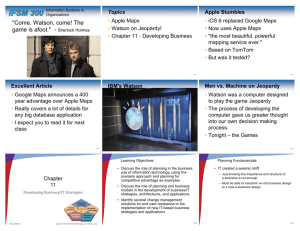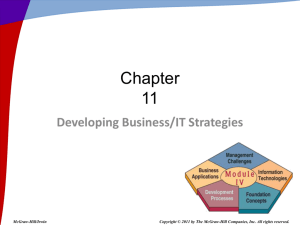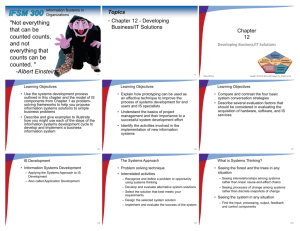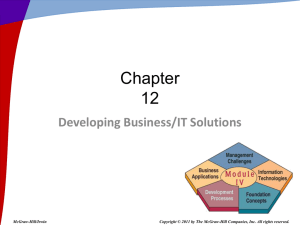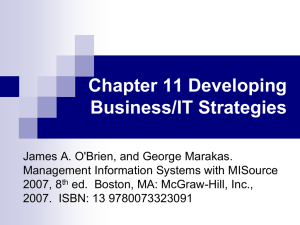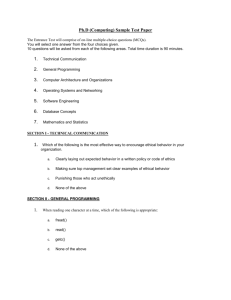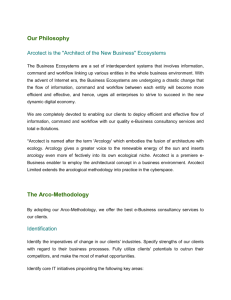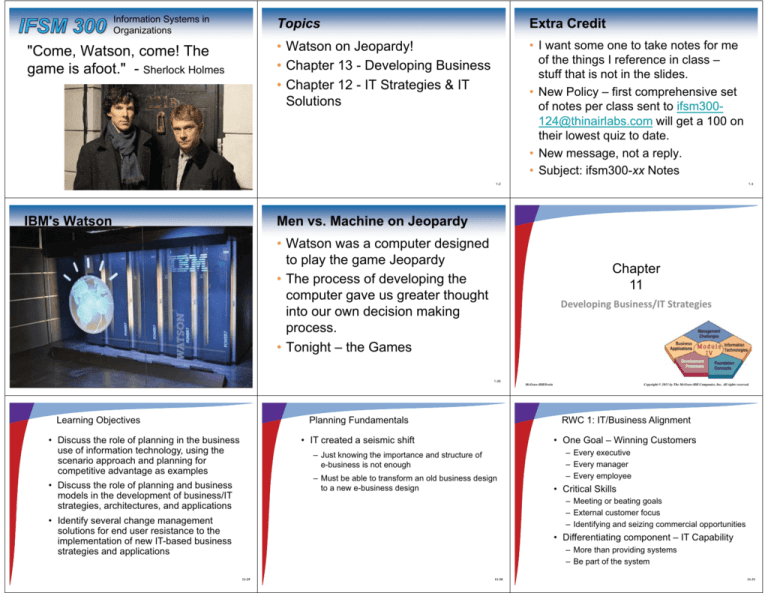
Information Systems in
Organizations
"Come, Watson, come! The
game is afoot." - Sherlock Holmes
Topics
Extra Credit
• Watson on Jeopardy!
• Chapter 13 - Developing Business
• Chapter 12 - IT Strategies & IT
Solutions
• I want some one to take notes for me
of the things I reference in class –
stuff that is not in the slides.
• New Policy – first comprehensive set
of notes per class sent to ifsm300124@thinairlabs.com will get a 100 on
their lowest quiz to date.
• New message, not a reply.
• Subject: ifsm300-xx Notes
1-1
1-2
1-1
IBM's Watson
1-3
1-2
1-3
Men vs. Machine on Jeopardy
• Watson was a computer designed
to play the game Jeopardy
• The process of developing the
computer gave us greater thought
into our own decision making
process.
• Tonight – the Games
1-25
Chapter
11
Developing Business/IT Strategies
1-26
1-25
1-26
McGraw-Hill/Irwin
Learning Objectives
• Discuss the role of planning in the business
use of information technology, using the
scenario approach and planning for
competitive advantage as examples
Planning Fundamentals
RWC 1: IT/Business Alignment
• IT created a seismic shift
• One Goal – Winning Customers
– Just knowing the importance and structure of
e-business is not enough
– Must be able to transform an old business design
to a new e-business design
• Discuss the role of planning and business
models in the development of business/IT
strategies, architectures, and applications
Copyright © 2011 by The McGraw-Hill Companies, Inc. All rights reserved.
– Every executive
– Every manager
– Every employee
• Critical Skills
– Meeting or beating goals
– External customer focus
– Identifying and seizing commercial opportunities
• Identify several change management
solutions for end user resistance to the
implementation of new IT-based business
strategies and applications
• Differentiating component – IT Capability
– More than providing systems
– Be part of the system
11-29
11-30
11-31
Components of Organizational Planning
Scenario Approach
Strategic Visioning Questions
• Gaining popularity
• Less formal
• Virtual world (microworld) exercises
• Business scenarios are created and evaluated
• Alternative scenarios are then created
11-32
Trends that Affect Strategic Planning
11-33
Strategic Opportunities Matrix
11-34
SWOT Analysis
• Strengths
– Core competencies and resources
• Weaknesses
– Areas of substandard business performance
• Opportunities
– Potential for new business markets or innovative
breakthroughs
• Threats
– Potential for business and market losses
11-35
Business Models and Planning
11-36
11-37
The Business/IT Planning Process
Questions for Business Models
• Vital questions
– Who are our customers?
– What do our customers value?
– How much will it cost to deliver that value?
– How do we make money in this business?
11-38
11-39
11-40
Information Technology Architecture
Balanced Scorecard
Balanced Scorecard Example
• Measures activities in terms of vision and
strategies
• Conceptual design components
– Technology platform
– Financial performance
– Data resources
– Impact on customers
– Application architecture
– Performance of key business processes
– IT organization
– Company’s learning curve and growth
• Four processes
– Translate vision into operational goals
– Communicate vision and link to performance
– Business planning
www.steelwedge.com
– Feedback/learning and strategy adjustment
11-41
11-42
Identifying Business/IT Strategies
Strategic Positioning Matrix
11-43
Strategic Matrix
• Cost and Efficiency Improvements
• Valuable Internet applications
– Low internal and low external connectivity
– Recommend – Use the Internet as a fast, low-cost
way to communicate and interact with others
– Transcend communication barriers
– Establish connections that enhance productivity
– Stimulate innovative development
• Performance Improvement in Effectiveness
– Improve customer relations
– High internal but low external connectivity
– Recommend – Increase use intranets and
extranets
11-44
11-45
Strategic Strategies
E-Business Strategy Examples
• Global Market Penetration
•
•
•
•
•
•
•
– High external but low internal connectivity
– Capitalize with e-commerce websites using
value-added information services and extensive
online customer support
• Product and Service Transformation
– High external and high internal connectivity
– Develop and deploy new Internet-based
products and services to create a new strategic
position in the marketplace
11-47
11-46
Business Application Planning Process
Market Creator
Channel Reconfiguration
Transaction Intermediary
Infomediary:
Self-Service Innovator
Supply Chain Innovator
Channel Mastery
11-48
11-49
Comparing Planning Approaches
E-Business Architecture Planning
Implementation Challenges
• Implementation
– Do what you planned to do
– Critical skill for managers
• Many companies are good at planning
• Few are good at executing the plan
– Even if senior management consistently identifies
e-business as an area of great opportunity and
critical need
11-50
RWC 2: Project Success
11-51
Implementing Information Technology
• People skills critical to project success
11-52
Impact and Scope of Implementing IT
• Developments that have generated
organizational change
– Teamwork
– Support during tough times
–
–
–
–
–
–
–
–
• Bad relationships leading cause of failure
• Managers tend to go to software instead of
building relations
• Showing progress at short intervals helps
Business process reengineering
ERP systems
Y2K compliance
Shared service centers
Just-in-time manufacturing
Sales force automation
Contract manufacturing
Introduction of Euro currency
• E-business is the latest catalyst
11-53
Impact and Scope of Implementing IT
11-54
End User Resistance and Involvement
11-55
Obstacles to KM Systems
• Change generates resistance
• Examples:
– Customer Relationship Management (CRM)
– Knowledge Management Systems (KM)
• CRM failures
– CRM failure rate up to 75 percent
– Causes for failure
• Sales force automation problems
• Unaddressed cultural issues
11-56
• Sales staffs fearful and thus resistant
11-57
11-58
Keys to Solving End User Resistance
Key Dimensions of Change Management
Change Management Programs
• Develop a change action plan
• Create relationships
– Understand the end-user’s situation
• Assign managers as change sponsors
• Provide education and training
• Require involvement and commitment
• Develop employee change teams
• Encourage open communications and
feedback about organizational changes
– End-users
– Top management
– All stakeholders
• Eliminate frustration and inconvenience
11-59
Change Management Tactics
11-60
11-61
A Change Management Process
Avnet Marshall’s Transformation
• Involve as many people as possible in ebusiness planning and application
development
• Make constant change an expected part of
the culture
• Tell everyone as much as possible about
everything, as often as possible, in person
• Make liberal use of financial incentives and
recognition
• Work within company culture, not around it
11-62
RWC 3: Crucial Strategic Planning Elements
11-63
11-64
RWC 4: The Science behind Change
• Implementing changes is very challenging
• Employees resist change
• Understanding can lead to smoother
transitions
• Not everyone is motivated by ambition
• Education and training aid with acceptance
• Alignment between business and IT
– IT strategic plan to improve the business-IT
relationship
– Articulate how IT fits into business and overall
business strategy.
• Apply clear strategy to business activities
11-65
Chapter
12
Developing Business/IT Solutions
11-66
McGraw-Hill/Irwin
Copyright © 2011 by The McGraw-Hill Companies, Inc. All rights reserved.
Learning Objectives
Learning Objectives
• Use the systems development process
outlined in this chapter and the model of IS
components from Chapter 1 as problemsolving frameworks to help you propose
information systems solutions to simple
business problems
• Describe and give examples to illustrate
how you might use each of the steps of the
information systems development cycle to
develop and implement a business
information system
Learning Objectives
• Explain how prototyping can be used as
an effective technique to improve the
process of systems development for end
users and IS specialists
• Compare and contrast the four basic
system conversation strategies
• Describe several evaluation factors that
should be considered in evaluating the
acquisition of hardware, software, and IS
services
• Understand the basics of project
management and their importance to a
successful system development effort
• Identify the activities involved in the
implementation of new information
systems
11-68
11-69
The Systems Approach
IS Development
• Information Systems Development
What is Systems Thinking?
• Problem solving technique
– Applying the Systems Approach to IS
Development
– Also called Application Development
• Seeing the forest and the trees in any
situation
• Interrelated activities
– Recognize and define a problem or opportunity
using systems thinking
– Develop and evaluate alternative system solutions
– Select the solution that best meets your
requirements
– Design the selected system solution
– Implement and evaluate the success of the system
11-71
– Seeing interrelationships among systems
rather than linear cause-and-effect chains
– Seeing processes of change among systems
rather than discrete snapshots of change
• Seeing the system in any situation
– Find the input, processing, output, feedback
and control components
11-72
Systems Thinking Example
RWC 1: Virtualization Helps Developers
•
•
•
•
11-73
Systems Analysis and Design (SA&D)
First used quietly for development tasks
Later introduced to IT Executives
Simplifies development and testing
Protection from system crashes
• Overall process
– Identification of business problems
– Design
– Implementation
– Create system snapshots and imaging
– Restore to last-known good version
• Two most common approaches
– Object-oriented analysis and design
• Doesn’t facilitate load testing
– Life cycle
– Need physical machine
11-74
11-70
11-75
11-76
Systems Development Lifecycle (SDLC)
Systems Development Process
Types of Feasibility Studies
• Systems Investigation
• Operational
– First step
– Consider multiple proposals
– Preliminary feasibility study
•
•
•
•
•
– Fix the problem, fit the organization
• Economic
– Cost/Benefit Analysis
Information needs of prospective users
Resource requirements
Costs
Benefits
Legal environment
• Technical
– Components and time available
• Human Factors
– Right people and roles available
– Feasibility study may be unnecessary
• Legal/Political
• Government mandate
11-77
Systems Analysis
– Government, patent, or license restrictions
11-78
Types of Analysis
• Produces the functional requirements
• Basis for the design of the new system
Functional Requirements
• Goal: what needs to be done, not how
• Organizational
– Structure, people, activities
• One of the most difficult steps
• Present System
• In-depth study
• Determine what type of information each
business activity requires
– Hardware, software, network, input, output,
processing
– Information needs
• Company
• Logical
• End users
• Determine the information processing
capabilities required for each system activity
– What the current system does
• Business stakeholders
11-79
– Not concerned with how it works
– Existing system
• Activities, resources, and products
11-80
Functional Requirements
11-81
Systems Design
11-82
Prototyping Life Cycle
• Focuses on three areas
11-83
11-84
11-85
User Interface Design
System Specifications
• Supports interactions between end users and
computer-based applications
• Components of formal design
– User interface methods and products
– Get help from end-users
– Database structures
– Designers create attractive and efficient forms
– Processing procedures
– Frequently a prototyping process
– Control procedures
– Produces detailed design specifications
• Examples of System Specifications
–
–
–
–
–
User interface specifications
Database specifications
Software specifications
Hardware and network specifications
Personnel specifications
11-86
Encouraging End User Web Development
•
•
•
•
•
End User Development
11-87
Object-Oriented Analysis and Design
11-88
Implementation Process
• Object – anything a programmer needs
manipulated
• Object-Oriented Programming (OOP)
techniques:
Look for tools that make sense
Spur creativity
Set some limits
Give managers responsibility
Make users comfortable
–
–
–
–
Inheritance
Modularity
Polymorphism
Encapsulation
• Object-Oriented Analysis (OOA)
– Model of object interaction, not solution
• Object-Oriented Design (OOD)
11-89
Sample Implementation Process
– Solution based on constraints
11-90
RWC 2: Difficult Path to Software Upgrades
11-91
Project Management
• System upgrades are daunting
• Failures are costly
• The skills and knowledge necessary to be a
good project manager will translate into
virtually any project environment
– Loss of immediate revenue
– Loss of customer loyalty
– Three to six month recovery
– Sought after by most organizations
• Contingency plans
– Backup website
– Extra operators in call center
• Packet implementation helps
– Basic install
– Additional features
11-92
11-93
11-94
What is a Project?
Phases of Project Management
Evaluating Hardware, Software, Services
• Establish minimum physical and performance
characteristics
• Every project has
–
–
–
–
–
–
A set of activities with a clear beginning and end
Goals
Objectives
Tasks
Limitations or constraints
A series of steps or phases
– Formalize in an RFP or RFQ
• Send RFQ to appropriate vendors
• Evaluate bids when received
–
–
–
–
• Managing a project effectively requires
– Process
– Tools
– Techniques
11-95
11-96
Hardware Evaluation Factors
•
•
•
•
•
•
•
•
•
•
Software Evaluation Factors
•
•
•
•
•
•
•
•
•
•
Performance
Cost
Reliability
Compatibility
Technology
Ergonomics
Connectivity
Scalability
Software
Support
All claims must be demonstrated
Obtain recommendations from other users
Search independent sources for evaluations
Benchmark test programs and test data
11-97
IS Services
• Examples of IS services
Most Hardware Evaluation Factors Apply
Quality
Efficiency
Flexibility
Security
Connectivity
Maintenance
Documentation
Hardware
Overall Rating
– Developing a company website
– Installation or conversion of hardware/software
– Employee training
– Hardware maintenance
– System design and/or integration
– Contract programming
– Consulting services
– Software that is slow, hard to use, bug-filled, or poorly
documented is not a good choice at any price
11-98
IS Service Evaluation Factors
Other Implementation Activities
11-100
Major System Conversion Strategies
• Testing
• IS evaluation factors include
–
–
–
–
–
–
–
11-99
Performance
Systems development
Maintenance
Conversion
Training
Backup facilities and services
Accessibility to sales and support
• Data conversion
• Documentation
• Training
• Business position and financial strength
– Hardware selection and compatibility
– Software packages offered
(Plunge)
11-101
11-102
11-103
Post-Implementation Activities
RWC 3: PayPal Going Global
• System Maintenance
RWC 4: Project Backlog
•
•
•
•
Demand for IT is increasing
Requests for IT projects are piling up.
Budget is not increasing.
Backlog is number-one barrier to
effectiveness,
• Two types of backlog
• How do global companies keep their
consumer sites updated in the local
language or localizing the content without
spending a lot of time and money?
• PayPal redesigned software
– Corrective: fix bugs and logical errors
– Adaptive: add new functionality
– Perfective: improve performance
– Preventive: reduce chances of failure
– Allow simultaneous refreshes for 15 locales
ranging from France to Poland.
• Post Implementation Review
– Correct Errors
– Backlog of desire
• Result
– Periodic review/audit
• Applications that users are yearning for
– Net total payment volume – $14 billion
– Backlog of commitment
• 12 percent of U.S. e-commerce
• 8 percent of global e-commerce.
• Single most costly activity
11-104
• Projects that are approved but not started
11-105
Closing Thought
• In The Sign of the
Four, Watson
quotes Holmes as
being "an
automaton, a
calculating
machine".
• I guess he got it
backwards…
End of this Lecture
1-107
1-107
1-108
1-108
• CIOs need to pay attention to both types of
a backlogs.
11-106

